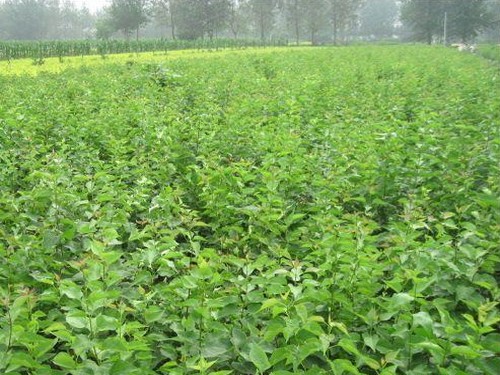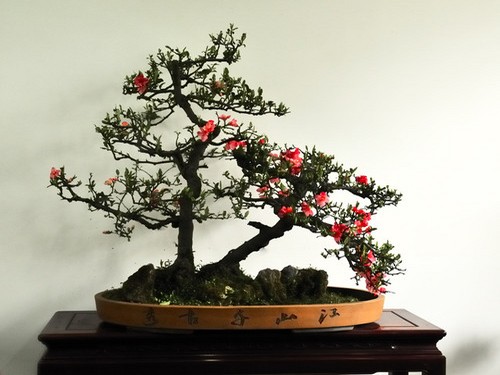Sowing and propagation technique of elderberry
Elderberry, also known as fair old, is a deciduous shrub to small tree of elderberry genus of Ninjuriaceae. It is widely distributed in the north and south of China and belongs to perennial tufted shrubs. The flower is white, the fruit is as red as fire, full of the whole tree, persistent. It has strong adaptability, drought tolerance, barren tolerance and can withstand the low temperature of-50 ℃. It is one of the common tree species in local landscaping. Elderberry can be propagated by cutting, ramet and sowing. Cutting and sowing propagation are simple and easy, and a large number of seedlings can be obtained at one time, which is the most commonly used. The following is to introduce the technology of sowing and propagation of elderberry.

When the fruit is ripe, collect seeds on the plants with good shape and strong growth, clean the seeds and place them in the shade, fill them with clean cloth bags, mix them with sand according to the ratio of 1 ∶ 3 in the first ten days of November, keep them moist, hide them in the shade in the open air, cover them with grass curtains or sacks, and often turn them over. At the beginning of April of the following year, the seeds were sown according to the seed amount of 15 grams per square meter. after sowing, the seeds were covered with clean fine sandy soil with a thickness of 0.5 cm. Seedlings could emerge in about 10 days, and seedlings could be selected in cloudy days after 3 to 4 leaves were grown. Weeds should also be pulled out in time during maintenance, urea should be applied in mid-June, cattle and horse dung should be applied at the end of autumn, and watered thoroughly with antifreeze water, and transplanting can be carried out the following spring.
1. Seed collection
Elderberry seeds mature early, and generally can be collected from late July to early August. The collected seeds are rubbed and peeled, then selected with clean water, soaked in 0.2%-0.5% alkaline water for 30 min, and then rinsed with clean water.
2. Select the place
It is suitable to choose leeward to the sun, high topography, convenient drainage and irrigation, high content of soil organic matter and sandy soil. In general, 2500 kg of organic fertilizer and 15 kg of potassium dihydrogen phosphate were applied every 667m 2, mix evenly and rake fine, and make seedlings with a width of 1.0m and a height of 15 cm.
3. Accelerate germination and sow
Elderberry seeds have the characteristic of dormancy and need to be treated alternately at high temperature and low temperature. In the first ten days of September, the seeds were mixed according to the sand ratio of 1 ∶ 3, the relative water content was kept at 60%, and the open sand was stored until the middle of April of the second year. Take out the seeds and sow them with a seed amount of 10 g per square meter, then sow 0.5% pentachloronitrobenzene poisonous soil on the seeds and cover the soil for 0.5 cm.
4. Seedling stage management
The main results are as follows: (1) the elderberry grows rapidly, and the timely seedling is the guarantee to cultivate strong seedlings. Generally, the first seedling was carried out 20 days after emergence, and the second seedling was carried out 35 days after seedling emergence with a distance of 10 cm;. The seedling was fixed 50 days after emergence with a distance of 15 cm;, and the plant spacing was 25 cm.
(2) in the early growth stage of herbicidal elderberry, the seedlings are thin and weak, and weeds should be removed in time, but in the later stage, elderberry grows faster, closes early, and there are fewer weeds.
(3) Water and fertilizer management: elderberry tissue has high water content and fast growth, so water and fertilizer management should be strengthened. Nitrogen fertilizer should be applied every 7-10 days, every 667 m 23-5 kg. In the last fertilization in the first ten days of August, potassium dihydrogen phosphate was sprayed 1 ~ 2 kg per 667m 2 to enrich the branches and survive the winter safely.
5. Overwintering management
In late September, the height of elderberry seedlings can reach 1.7m and the ground diameter is 2 cm. In the middle and late October, the one-year-old seedlings are dug up and placed in the cellar, the roots are aligned, the roots are covered with sand, and the growing strips are heaped. Finally, the roots are watered and the pit temperature is kept at-3 ℃ ~ 5 ℃ and stored until the following year.
Time: 2019-06-11 Click:
- Prev

Watering skills of potted crabapple with sticking stem
Stick stem begonia can withstand drought, although afraid of stagnant water, but still prefer a wet environment, so do not give it less or no watering because it is afraid of stagnant water. Tripterygium is more resistant to drought and is generally dry and thoroughly watered during the growing period. Avoid noon when spraying and watering in summer. Although sticking Begonia is afraid of stagnant water
- Next

Control of diseases and insect pests of edible fungi, how to control brown rot of edible fungi?
How to prevent and cure edible fungus brown rot?
Related
- Fuxing push coffee new agricultural production and marketing class: lack of small-scale processing plants
- Jujube rice field leisure farm deep ploughing Yilan for five years to create a space for organic food and play
- Nongyu Farm-A trial of organic papaya for brave women with advanced technology
- Four points for attention in the prevention and control of diseases and insect pests of edible fungi
- How to add nutrient solution to Edible Fungi
- Is there any good way to control edible fungus mites?
- Open Inoculation Technology of Edible Fungi
- Is there any clever way to use fertilizer for edible fungus in winter?
- What agents are used to kill the pathogens of edible fungi in the mushroom shed?
- Rapid drying of Edible Fungi

